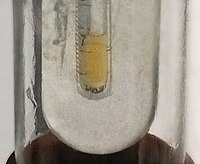
Photo from wikipedia
Abstract The traditional method of cloning formation is used to study the radiation effect of nuclear physics rays on hepatoma cells, and the results obtained are not reliable. Therefore, a… Click to show full abstract
Abstract The traditional method of cloning formation is used to study the radiation effect of nuclear physics rays on hepatoma cells, and the results obtained are not reliable. Therefore, a new method of studying the radiation effect of nuclear physics rays on hepatoma cells is proposed. PCC method is used to study the radiation effect of γ-rays on hepatoma cells. Radiation effects of X-rays on hepatoma cells were studied by radionuclide formation assay, neutral comet electrophoresis and γH2AX focal detection. The results showed that the survival curves of HepG2 hepatoma cells irradiated by γ-rays were well fitted by linear squares. There was a linear relationship between the survival rate and irradiation dose of HepG2 hepatoma cells irradiated by γ-rays. HepG2 hepatoma cells showed strong tolerance to X-ray irradiation, and the positive rate of γH2AX cells reached 100% in each dose group only 0.5 h after X-ray irradiation.
Journal Title: Open Physics
Year Published: 2019
Link to full text (if available)
Share on Social Media: Sign Up to like & get
recommendations!